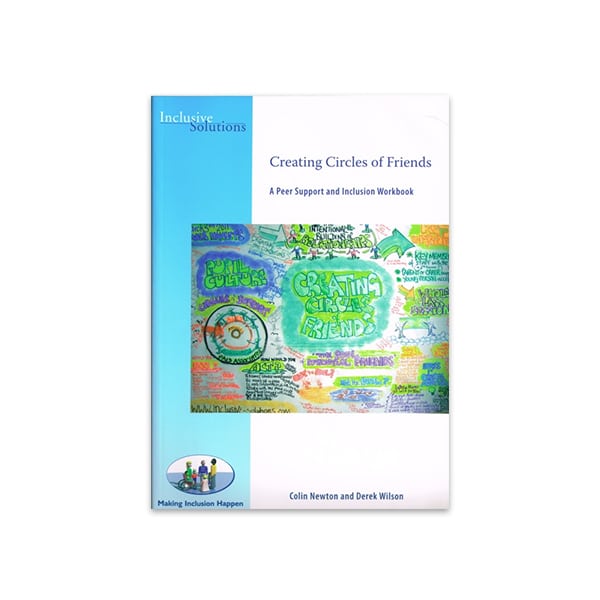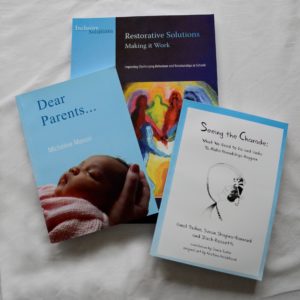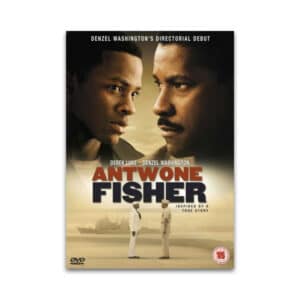Description
Format: A4, 96 pages
ISBN: 0-9546351-0-8
Description: Creating Circles of Friends By Colin Newton and Derek Wilson – Inclusive Solutions This is a revised version of the original text by the authors: ‘Circles of Friends’. The book is a must for anyone interested in building friendships and relationships around those vulnerable or challenging through reason of disability or emotional need. Building respectful teams of support around an individual, tapping into that child’s peer group is an extremely powerful way of promoting change and insights for all involved. Circle of friends, is ultimately a tool for inclusion and is based on solid values as well as practical processes. The book describes both the values and the practical application of this approach to human change. What is more the approach works!





Colin Newton –
I read your Creating Circles of Friends book from cover to cover over the summer and found it truly inspiring. I am hoping to work with my schools this year on introducing and persuading them to trust and believe in this very powerful and effective approach. I just hope that I can convey the enthusiasm and passion that your book has instilled in me.
Dr Bryony Curtis – Educational Psychologist
Colin Newton –
‘This book has been based on Canadian Research and offers a simple but well-tried and tested solution/technique to help with re-integration into main stream classroom for children with behavioural problems.
The “Circle of Friends” technique is based on inclusion rather than exclusion and works by looking at the problem the child has in their social life and by involving their classmates to help them rebuild their social circle. This ultimately leads to the child learning more appropriate social behaviour, which will enable them to get on better with their peers. Obviously this in turn helps them to rebuild a peer group relationship and to continue to work on problems that will lead to more acceptance and inclusion rather than exclusion from these groups.
Using step by step directions on how to set up a “circle of Friends” case studies and examples/templates of handouts which can be used both by parents in the home situation and by others who work with or care for the children out of school activities and well as being used in school. This helps to reinforce the technique across all aspects of the child’s life which essential for optimum consistency and effect.
The authors bring the “circle of friends” technique in an easy to read and well set out and written format. This gives everyone who reads this the encouragement to use the technique to its full potential. Therefore giving the child support, encouragement and help to integrate back with maximum chance of success for acceptance and friendship.
Ideal for use in all schools especially with those children who are on the verge of exclusion.’
Caroline Hensby – adders.org
Colin Newton –
‘This book has been written by practising educational psychologists who are deeply committed to the inclusion of all pupils in mainstream schools. It begins by looking briefly at the idea, rationale and origins of Circles of Friends, which Colin and Derek define as:
“… an approach to enhancing the inclusion, in a mainstream setting, of any young person (known as the ‘focus child’), who is experiencing difficulties in school because of a disability, a personal crisis or his or her challenging behaviour towards others. (This approach) works by mobilising the young person’s peers to provide support and engage in problem-solving with the person in difficulty” (p.4).
The authors continue that it is for all people – including educational psychologists, teachers and youth workers – who work with youngsters who are labelled and marginalised in various ways. “Ultimately”, they say, “it is a book for everyone because at some time in our lives, all of us are likely to have needs that are not typical” (p.4).
Beyond the two introductory chapters, the book systematically and thoroughly outlines the processes involved in establishing Circles of Friends from ‘Getting Started’ to examining the ‘Circle in Action’. Further chapters consider the issues of teacher and pupil outcomes, case studies, the theoretical basis of Circles of Friends and FAQs (Frequently Asked Questions). Based on the authors’ extensive professional experiences, these chapters are full of sound practical advice for those wishing to adopt this powerful strategy. The book concludes with a comprehensive and up-to-date appendix of additional resources, including video material and internet websites, to which the interested reader might turn for further ideas and information.
As a whole, the book is written in a lively, non-technical, engaging manner with numerous cartoon-style illustrations and it is highly recommended reading for all people who are professionally involved in trying to help children with relationship difficulties.’
Professor Helen Cowie, School of Psychology and Counselling, University of Surrey Roehampton
Colin Newton –
“As in the first edition, the technique is clearly described, there are many practical examples and all of the original summary sheets (for parents, teachers and other professionals) are included. As the title suggests, the book can be used as a manual or workbook for working with teachers and other professionals.
Throughout the book, the authors promote their technique within a broad context of inclusion. The style is upbeat and demonstrates an unquestioning commitment to inclusive practice. As we are told, this is in keeping with developments in education in the United Kingdom and takes into account children’s rights. While the emphasis may be supported by the majority of EPs, teachers and other professionals in the field, I question whether it would be likely to persuade those who are less in tune with inclusive practice.
The 96 pages include 14 pages of references, 12 of which list resources available through Inclusive Solutions (e.g., videos, DVDs, and training. on a variety of themes). This gives further weight to the book being, first and foremost, a practical resource for educationalists who wish to promote inclusive practice. The Circle of Friends technique is thus presented in a much broader context than in the original text.
For those who do not have access to the original text, this workbook is an essential piece of EP equipment. I would recommend it to all educational practitioners who wish to promote inclusive practice.”
– Janet Connelly, Sunderland Educational Psychology Service
Ruby Corbett –
This book is a truly brilliant read with a great insight into creating a circle of friends, there are plenty of practical examples. The book can help all kinds of people including psychologists, teachers as a practical or manual thing for them to work with. An eye opening piece into the practice of inclusion.